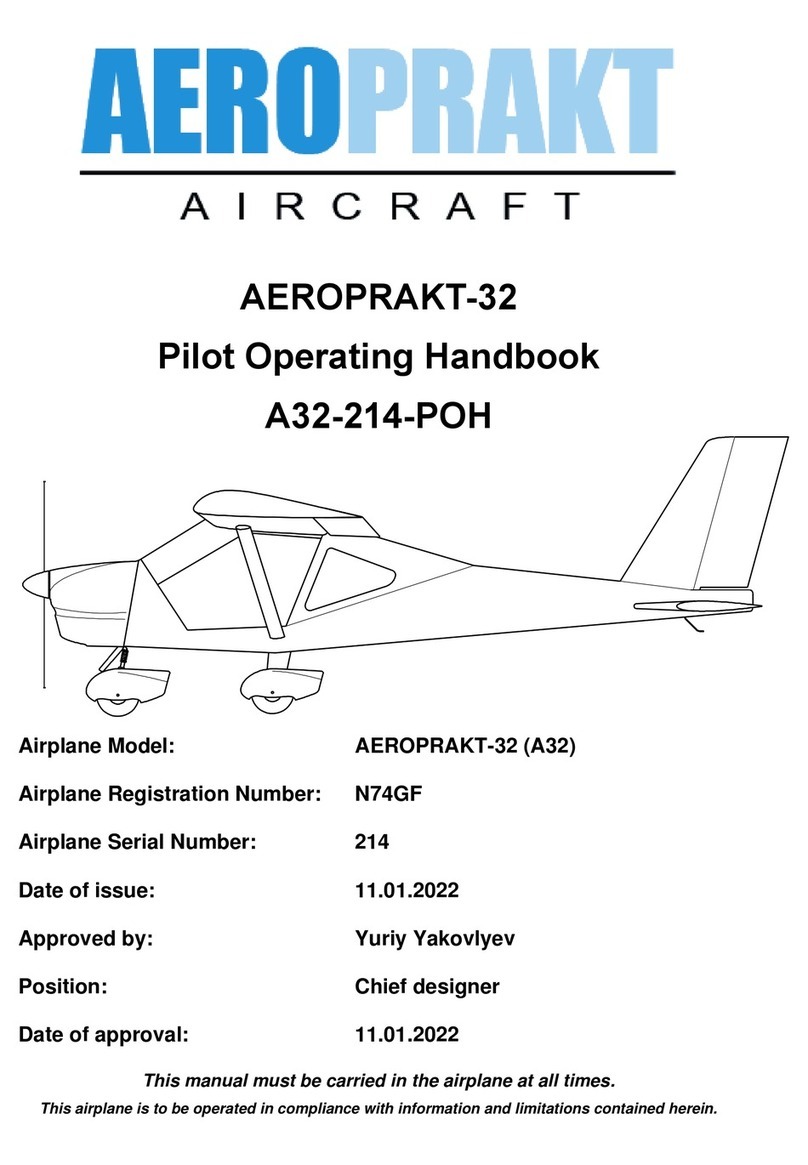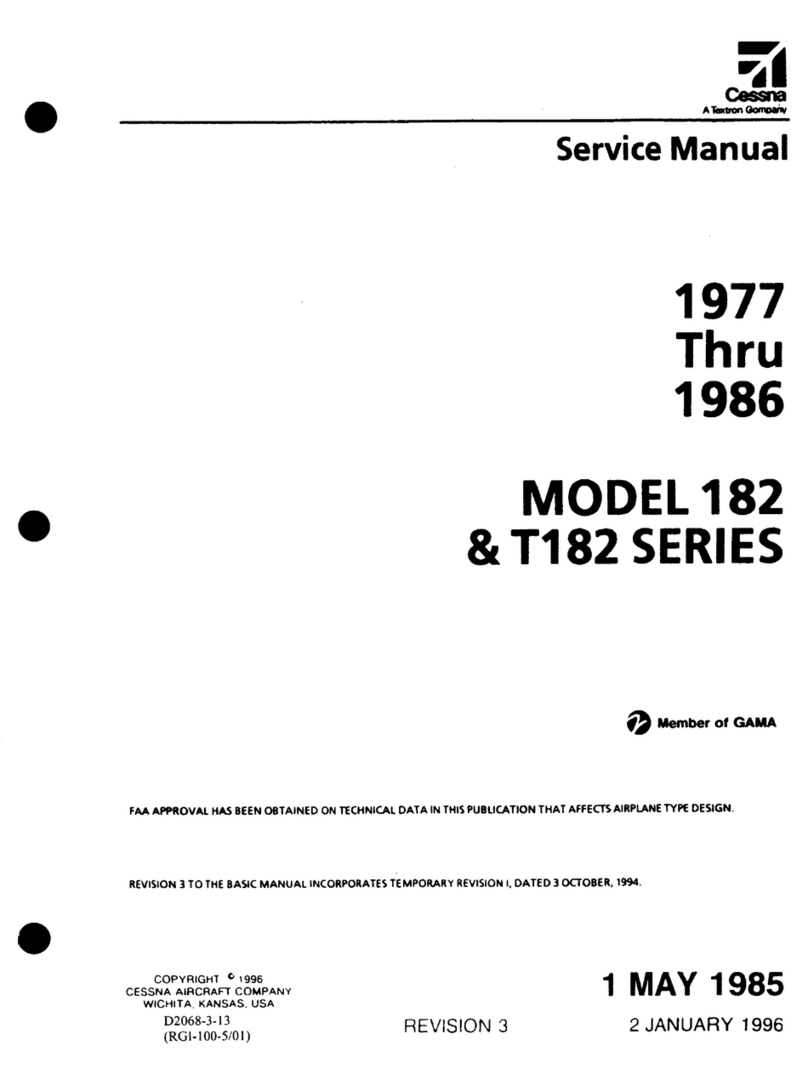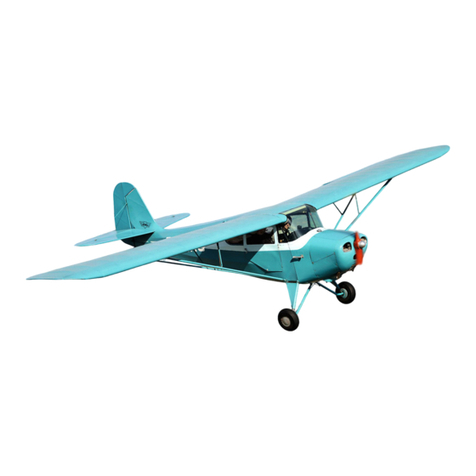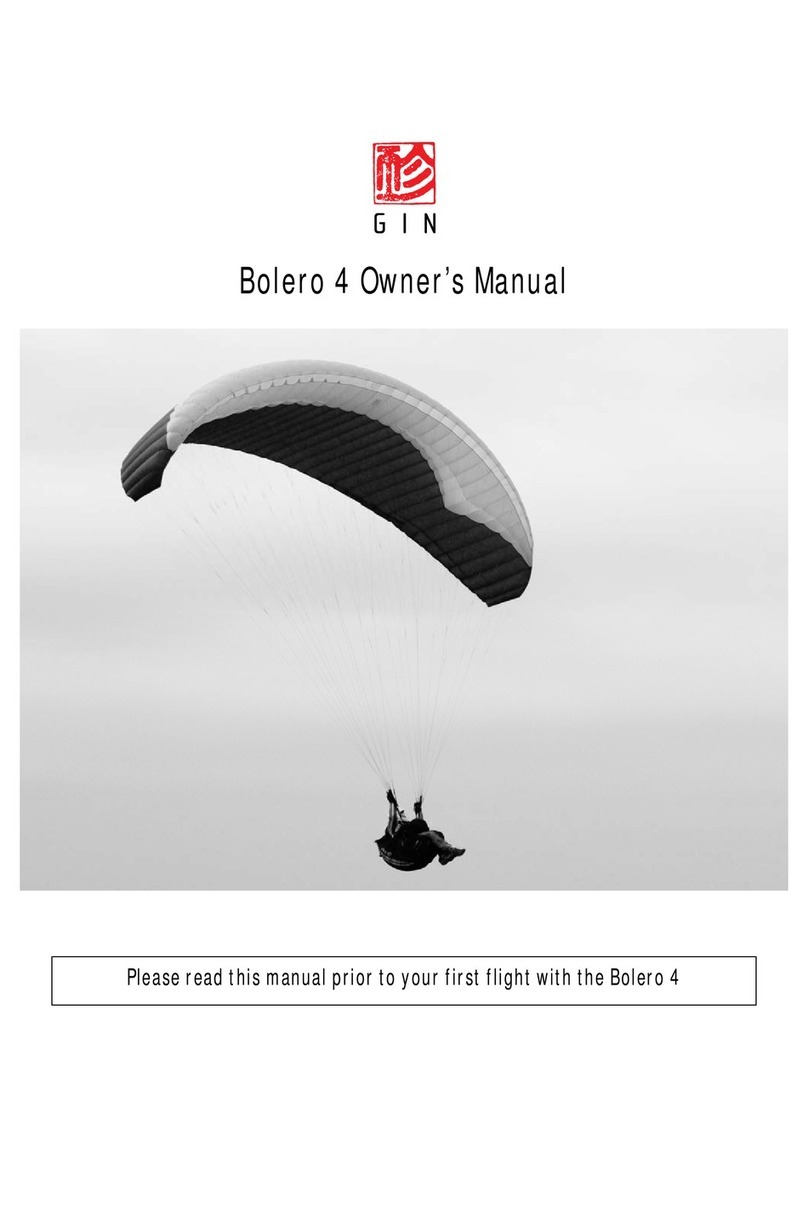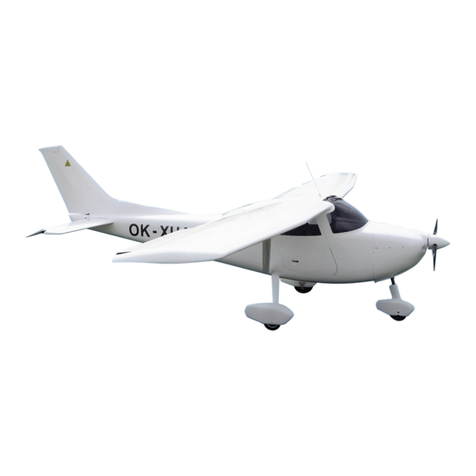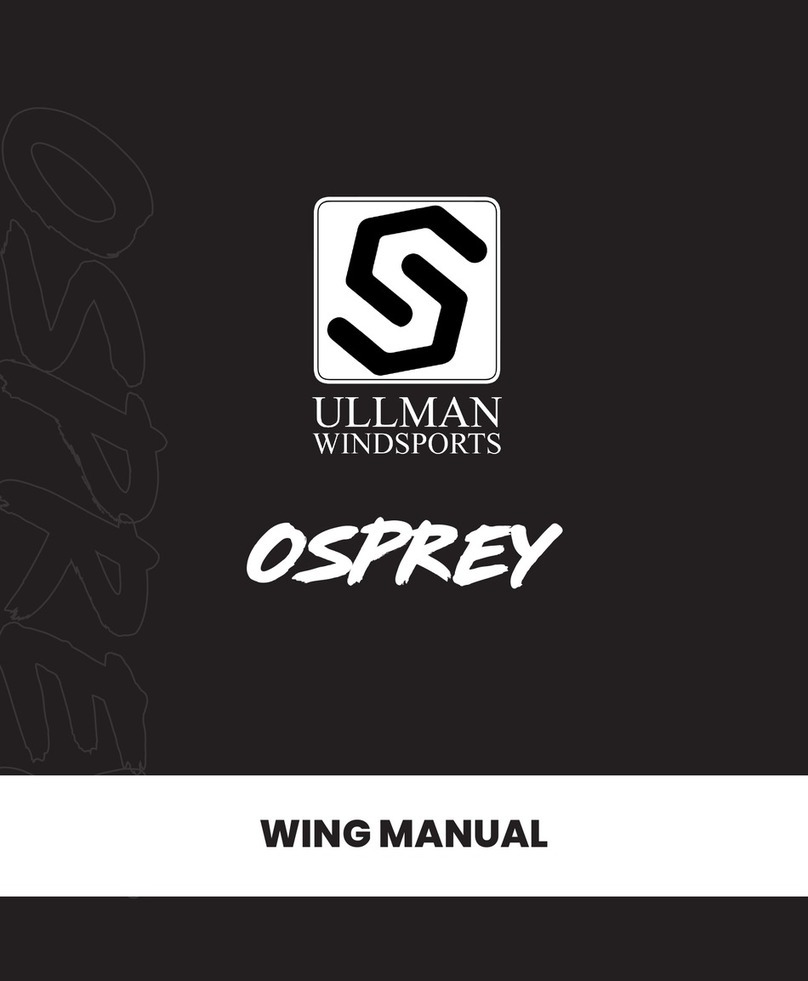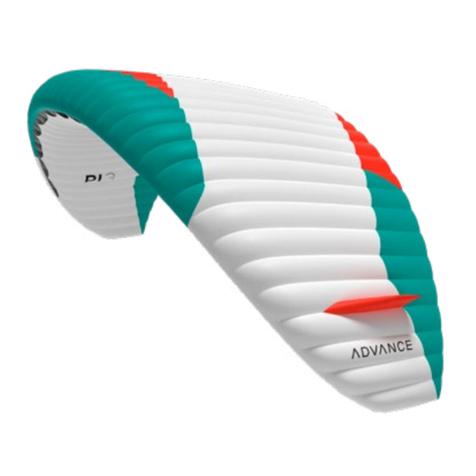AUTO GYRO Cavalon Owner's manual

Pilot Operating Handbook
Cavalon | Rotax 915 IS

AutoGyro_POH_Cavalon 915iS Revision 1.0 – Issue Date 08.MAY.2019 Pre-pages 1
Pilot Operating Handbook
for Gyroplane Cavalon 915iS

AutoGyro_POH_Cavalon 915iS Revision 1.0 – Issue Date 08.MAY.2019 Pre-pages 2
All rights reserved. Under the copyright laws, this manual may not be copied, in whole or in part, without the written
consent of AutoGyro GmbH. AutoGyro reserves the right to change or improve its products and to make changes in the
content of this manual without obligation to notify any person or organisation of such changes or improvements.
Notifications to the Civil Aviation Authorities or other organisations based on legal regulations are unaffected.
MTOsport, Calidus, Cavalon, the AutoGyro logo and word picture mark are trademarks or registered trademarks of
AutoGyro AG, registered in Germany and other countries.
Other company and product names mentioned herein may be trademarks of their respective companies. Mention of third-
party products is for informational purposes only and constitutes neither an endorsement nor a recommendation. AutoGyro
assumes no responsibility with regard to the performance or use of these products. All understandings, agreements, or
warranties, if any, take place directly between the vendors and the prospective users.
U.S. and foreign patents of AutoGyro AG are used in the Calidus and Cavalon gyroplanes - (US.Pat.No. 8,690,100;
US.Pat.No. D699,153)
Every effort has been made to ensure that the information in this manual is accurate. AutoGyro GmbH is not responsible
for printing or clerical errors.

AutoGyro_POH_Cavalon 915iS Revision 1.0 – Issue Date 08.MAY.2019 Pre-pages 3
Pilot Operating Handbook for Gyroplane Cavalon fitted with
the Rotax 915iS engine
Model: ______________________________________________
Serial number: ______________________________________________
Registration: ______________________________________________
Type certificate number: ______________________________________________
Aircraft manufacturer and
type certificate holder: AutoGyro GmbH,
Dornierstraße 14
D-31137 Hildesheim
Tel.: +49 (0) 51 21 / 8 80 56-00
Fax: +49 (0) 51 21 / 8 80 56-19
Distribution partner: ______________________________________________
______________________________________________
______________________________________________
Owner: ______________________________________________
______________________________________________
______________________________________________
This flight manual is always to be carried on board of the aircraft and must be kept in
current, up-to-date status. The latest revisions and version status is available at
www.auto-gyro.com. Extent and revision status of the manual is recorded in the revision log
and the table of content.
This gyroplane may be operated only in strict compliance with the limitations and
procedures contained in this manual.
The manual is not a substitute for competent theoretical and practical training on the
operation of this aircraft. Failure to adhere to its provisions or to take proper flight
instruction can have high-risk consequences.

AutoGyro_POH_Cavalon 915iS Revision 1.0 – Issue Date 08.MAY.2019 Pre-pages 4
REVISION LOG
Rev. Inserted by Date Signature
1.0 AutoGyro GmbH 08.MAY.2019

Pilot Operating Handbook
Cavalon Table of Contents
List of Effective Pages
AutoGyro_POH_Cavalon 915iS Revision 1.0 – Issue Date 08.MAY.2019 Index / LOEP 1
CONTENTS
SECTION 1 - GENERAL...................................................................................................1-1
1.1 Introduction.................................................................................................... 1-1
1.2 Certification ................................................................................................... 1-1
1.3 Performance Data and Operating Procedures ............................................... 1-1
1.4 Definition of Terms ........................................................................................ 1-2
1.5 Important Note...............................................................................................1-2
1.6 Three-view of the Cavalon............................................................................. 1-3
1.7 Description .................................................................................................... 1-4
1.8 Technical Data ..............................................................................................1-4
1.9 Rotor ............................................................................................................. 1-4
1.10 Engine........................................................................................................... 1-5
1.11 Propeller........................................................................................................ 1-5
1.12 Unit Conversion.............................................................................................1-6
1.13 Abbreviations and Terminology .....................................................................1-7
SECTION 2 - LIMITATIONS .............................................................................................2-1
2.1 General .........................................................................................................2-1
2.2 Environmental Limitations..............................................................................2-2
2.3 Colour Code for Instrument Markings ............................................................2-3
2.4 Airspeed Limitations and Instrument Markings...............................................2-4
2.5 Rotor Speed Limitations and Instrument Markings.........................................2-4
2.6 Power Plant Limitations and Instrument Markings.......................................... 2-5
2.7 Weight and Balance ......................................................................................2-7
2.8 Flight Crew .................................................................................................... 2-8
2.9 Kinds of Operation.........................................................................................2-8
2.10 Fuel ............................................................................................................... 2-9
2.11 Minimum Equipment.................................................................................... 2-10
2.12 Placards ...................................................................................................... 2-11
SECTION 3 - EMERGENCY PROCEDURES ................................................................... 3-1
3.1 Engine Failure ...............................................................................................3-1
3.2 Air Restart Procedure .................................................................................... 3-2
3.3 Landing into Trees or High Vegetation...........................................................3-3
3.4 Degradation of Engine Power ........................................................................ 3-3
3.5 Evacuating the Aircraft................................................................................... 3-3
3.6 Smoke and Fire .............................................................................................3-3
3.7 Off-field Landing ............................................................................................ 3-4
3.8 Flight Control Malfunction ..............................................................................3-4
3.9 Pitch oscillation recovery ............................................................................... 3-6
3.10 Vibration........................................................................................................ 3-6
3.11 Other equipment failure ................................................................................. 3-7
3.12 Door open in flight. ........................................................................................ 3-9
3.13 Warning and Caution Lights...........................................................................3-9

Pilot Operating Handbook
Cavalon Table of Contents
List of Effective Pages
AutoGyro_POH_Cavalon 915iS Revision 1.0 – Issue Date 08.MAY.2019 Index / LOEP 2
3.14 Parameters out of Limits ............................................................................. 3-12
3.15 Outside Air Temperature Temperature........................................................ 3-12
3.16 Loss of Visibility........................................................................................... 3-12
3.17 Rotor Icing................................................................................................... 3-13
3.18 Landing with a Deflated Tyre....................................................................... 3-13
3.19 Failure of CSP/VPP Propeller (if installed)................................................... 3-13
3.20 Alternative Method of Engine Shut-down..................................................... 3-14
SECTION 4 - NORMAL PROCEDURES .......................................................................... 4-1
4.1 Airspeeds for Safe Operation ........................................................................ 4-1
4.2 Preparation for Flight..................................................................................... 4-1
4.3 Daily or Pre-flight Checks.............................................................................. 4-1
4.4 Before Boarding ............................................................................................ 4-5
4.5 Before Starting Engine .................................................................................. 4-6
4.6 Starting Engine.............................................................................................. 4-6
4.7 Taxi and Run-up............................................................................................ 4-7
4.8 Take-off Procedure ..................................................................................... 4-10
4.9 Take-off Run ............................................................................................... 4-12
4.10 Climb........................................................................................................... 4-12
4.11 Cruise ......................................................................................................... 4-13
4.12 Descent....................................................................................................... 4-13
4.13 Approach..................................................................................................... 4-13
4.14 Landing ....................................................................................................... 4-14
4.15 Go-around................................................................................................... 4-14
4.16 After Landing............................................................................................... 4-14
4.17 Engine Shut-down....................................................................................... 4-15
4.18 Parking........................................................................................................ 4-16
4.19 Special Procedure: Short Field Take-off...................................................... 4-16
4.20 Special Procedure: Slow Speed Sink and Recovery.................................... 4-17
4.21 Flight under Conditions of Precipitation ....................................................... 4-17
4.22 Flight with Doors Removed ......................................................................... 4-17
4.23 Engine In-flight Shut-down and Air Restart.................................................. 4-18
4.24 Dropping of Parachutists (where market regulations allow) ......................... 4-19
4.25 Noise Abatement......................................................................................... 4-21
SECTION 5 - PERFORMANCE........................................................................................ 5-1
5.1 Demonstrated Operating Temperature .......................................................... 5-1
5.2 Airspeed Correction....................................................................................... 5-1
5.3 Height-Velocity Diagram................................................................................ 5-2
5.4 Speeds.......................................................................................................... 5-3
5.5 Rate of Climb ................................................................................................ 5-3
5.6 Take-off and Landing Data............................................................................ 5-3
5.7 Influence on Take-off Distance and Climb Rate............................................. 5-5
5.8 Sink Rate and Glide Ratio ............................................................................. 5-7
5.9 Additional Performance Data......................................................................... 5-7

Pilot Operating Handbook
Cavalon Table of Contents
List of Effective Pages
AutoGyro_POH_Cavalon 915iS Revision 1.0 – Issue Date 08.MAY.2019 Index / LOEP 3
5.10 Sound Exposure Level / Noise Characteristics .............................................. 5-8
5.11 High Altitude Operation.................................................................................. 5-8
SECTION 6 - WEIGHT AND BALANCE............................................................................ 6-1
6.1 General .........................................................................................................6-1
6.2 Weight and Balance Record .......................................................................... 6-1
6.3 Compliance with Weight and Balance............................................................ 6-1
6.4 Lateral Centre of Gravity................................................................................ 6-1
SECTION 7 - SYSTEM DESCRIPTION ............................................................................ 7-1
7.1 Introduction.................................................................................................... 7-1
7.2 Airframe and Undercarriage...........................................................................7-1
7.3 Doors, Windows and Exits............................................................................. 7-1
7.4 Fuel System ..................................................................................................7-2
7.5 Pneumatic System......................................................................................... 7-2
7.6 Power Plant................................................................................................... 7-4
7.7 Propeller........................................................................................................ 7-4
7.8 Rotor System................................................................................................. 7-5
7.9 Vibration Damping.........................................................................................7-5
7.10 Flight Controls ............................................................................................... 7-5
7.11 Electrical System........................................................................................... 7-8
7.12 Lighting System........................................................................................... 7-10
7.13 Electrical circuit protection ........................................................................... 7-11
7.14 Avionics....................................................................................................... 7-12
7.15 Instrument Panel ......................................................................................... 7-14
7.16 Cabin Fresh Air ........................................................................................... 7-22
7.17 Intercom ...................................................................................................... 7-22
7.18 Pitot Static ................................................................................................... 7-23
7.19 Indicators and Sensors ................................................................................ 7-23
7.20 Seats and Seatbelts .................................................................................... 7-23
7.21 Stowage Capacity........................................................................................ 7-24
7.22 Fire-warning system .................................................................................... 7-24
SECTION 8 - HANDLING AND SERVICING.....................................................................8-1
8.1 Maintenance Obligations ............................................................................... 8-1
8.2 General .........................................................................................................8-1
8.3 Ground Handling ........................................................................................... 8-2
8.4 Cleaning........................................................................................................ 8-2
8.5 Refuelling ......................................................................................................8-2
8.6 Checking of Engine Oil Level.........................................................................8-3
8.7 Checking of Engine Coolant Level .................................................................8-4
8.8 Tyre Pressure................................................................................................ 8-4
8.9 Lubrication and Greasing............................................................................... 8-4
8.10 Replenishing of Fluids ................................................................................... 8-5
8.11 Engine Air Filter.............................................................................................8-5
8.12 Propeller........................................................................................................ 8-5

Pilot Operating Handbook
Cavalon Table of Contents
List of Effective Pages
AutoGyro_POH_Cavalon 915iS Revision 1.0 – Issue Date 08.MAY.2019 Index / LOEP 4
8.13 Battery .......................................................................................................... 8-5
8.14 Winter Operation........................................................................................... 8-5
8.15 Removal, Disassembly, Assembly and Installation of the Rotor..................... 8-6
8.16 Road Transport ........................................................................................... 8-11
8.17 Repairs ....................................................................................................... 8-11
SECTION 9 - SUPPLEMENTS .......................................................................................... 9-i
9-1 Variable Pitch Propeller – Woodcomp KW-30................................................................ 1
9-1.1 General ............................................................................................................ 1
9-1.2 Limitations........................................................................................................ 1
9-1.3 Emergency Procedures.................................................................................... 1
9-1.4 Normal Procedures .......................................................................................... 1
9-1.5 Performance .................................................................................................... 2
9-1.6 Weight and Balance ......................................................................................... 2
9-1.7 System Description .......................................................................................... 2
9-1.8 Handling and Servicing .................................................................................... 3
9-2 Lights ............................................................................................................................ 1
9-2.1 General ............................................................................................................ 1
9-2.2 Limitations........................................................................................................ 1
9-2.3 Emergency Procedures.................................................................................... 1
9-2.4 Normal Procedures .......................................................................................... 1
9-2.5 Performance .................................................................................................... 1
9-2.6 Weight and Balance ......................................................................................... 1
9-2.7 System Description .......................................................................................... 1
9-2.8 Handling and Servicing .................................................................................... 2
9-3 GPS/Moving Map Systems............................................................................................ 1
9-3.1 General ............................................................................................................ 1
9-3.2 through 9-3.6 ......................................................................................................... 1
9-3.7 System Description .......................................................................................... 1
9-3.8 Handling and Servicing .................................................................................... 1
9-4 Fire Indication................................................................................................................ 1
9-4.1 General ............................................................................................................ 1
9-4.2 Limitations........................................................................................................ 1
9-4.3 Emergency Procedures.................................................................................... 1
9-4.4 through 9-4.9 ......................................................................................................... 1
9-6 ELT (Emergency Locator Transmitter)........................................................................... 1
9-6.1 General ............................................................................................................ 1
9-6.2 Limitations........................................................................................................ 1
9-6.3 Emergency Procedures.................................................................................... 1
9-6.4 Normal Procedures .......................................................................................... 1
9-6.5 through 9-6.6 ......................................................................................................... 1
9-6.7 System Description .......................................................................................... 1
9-6.8 Handling and Servicing .................................................................................... 2
9-7 Removal/Installation of Doors........................................................................................ 1
9-7.1 General ............................................................................................................ 1

Pilot Operating Handbook
Cavalon Table of Contents
List of Effective Pages
AutoGyro_POH_Cavalon 915iS Revision 1.0 – Issue Date 08.MAY.2019 Index / LOEP 5
9-7.2 Limitations ........................................................................................................ 1
9-7.3 Emergency Procedures .................................................................................... 1
9-7.4 Normal Procedures........................................................................................... 1
9-7.5 Performance..................................................................................................... 1
9-7.6 Weight and Balance ......................................................................................... 1
9-7.7 System Description........................................................................................... 1
9-7.8 Handling and Servicing..................................................................................... 2
9-8 Instructor Throttle Lever................................................................................................. 1
9-8.1 General ............................................................................................................ 1
9-8.2 through 9-8.6 ......................................................................................................... 1
9-8.7 System Description........................................................................................... 1
9-8.8 Handling and Servicing..................................................................................... 1
9-9 Alternative Rotor System 8.6 m...................................................................................... 1
9-9.1 General ............................................................................................................ 1
9-9.2 Limitations ........................................................................................................ 1
9-9.3 Emergency Procedures .................................................................................... 1
9-9.4 Normal Procedures........................................................................................... 1
9.9.5 Performance..................................................................................................... 1
9-9.6 Weight and Balance ......................................................................................... 1
9-9.7 System Description........................................................................................... 1
9-9.8 Handling and Servicing..................................................................................... 1
9-10 Mobility Equipment........................................................................................................ i
9-10.1 General ............................................................................................................. i
9-10.2 through 9-10.3....................................................................................................... i
9-10.4 Normal Procedures............................................................................................ i
9-10.5 through 9-11.6....................................................................................................... i
9-10.7 System Description............................................................................................ i
9.10.8 Handling and Servicing..................................................................................... ii
SECTION 10 - SAFETY TIPS ......................................................................................... 10-1
Low-G Avoidance....................................................................................................... 10-1
Side Slip in Gyroplanes.............................................................................................. 10-1
Flying Low on Fuel Is Dangerous............................................................................... 10-2
Do Not Push the Envelope and Remain Easy On the Controls................................... 10-2
Strobe Lights On – For Your Own and Other’s Safety ................................................ 10-2
Propellers and Rotors Can Be Extremely Dangerous.................................................10-2
Power Lines and Cables Are Deadly ..........................................................................10-2
Loss of Visibility Can Be Fatal .................................................................................... 10-2
Overconfidence Prevails in Accidents ........................................................................ 10-3
Flying Low over Water is Very Hazardous..................................................................10-3
Conversion Pilots Constitute High Risk When Flying Gyroplanes............................... 10-3
Beware of Demonstration or Initial Training Flights .................................................... 10-4
Training Off-Field Simulated Engine Failures ............................................................. 10-4
APPENDIX ..................................................................................................................... 10-1
Operator Registration Form

Pilot Operating Handbook
Cavalon Table of Contents
List of Effective Pages
AutoGyro_POH_Cavalon 915iS Revision 1.0 – Issue Date 08.MAY.2019 Index / LOEP 6
Customer Feedback Form
Incident Reporting Form

Pilot Operating Handbook
Cavalon Table of Contents
List of Effective Pages
AutoGyro_POH_Cavalon 915iS Revision 1.0 – Issue Date 08.MAY.2019 Index / LOEP 7
LIST OF EFFECTIVE PAGES
Page(s)
Rev.
Date
Page(s)
Rev.
Date
1-1 to 1-8 3.1 08.MAY.2019 9-3 – 1 to 1 3.1 08.MAY.2019
2-1 to 2-19 3.1 08.MAY.2019 9-4 – 1 to 1 3.1 08.MAY.2019
3-1 to 3-14 3.1 08.MAY.2019 9-5 - 1 to 2 3.1 08.MAY.2019
4-1 to 4-18 3.1 08.MAY.2019 9-6 – 1 to 2 3.1 08.MAY.2019
5-1 to 5-8 3.1 08.MAY.2019 9-7 – 1 to 2 3.1 08.MAY.2019
6-1 to 6-1 3.1 08.MAY.2019 9-8 – 1 to 1 3.1 08.MAY.2019
7-1 to 7-24 3.1 08.MAY.2019 9-9 – 1 to 1 3.1 08.MAY.2019
8-1 to 8-11 3.1 08.MAY.2019 9-10 – 1 to 2 3.1 08.MAY.2019
9-1 – 1 to 4 3.1 08.MAY.2019 10-1 to 10-4 3.1 08.MAY.2019
9-2 – 1 to 2 3.1 08.MAY.2019

Pilot Operating Handbook
Cavalon Table of Contents
List of Effective Pages
AutoGyro_POH_Cavalon 915iS Revision 1.0 – Issue Date 08.MAY.2019 Index / LOEP 8
INTENTIONALLY LEFT BLANK

Pilot Operating Handbook
Cavalon SECTION 1
GENERAL
AutoGyro_POH_Cavalon 915iS Revision 1.0 – Issue Date 08.MAY.2019 1-i
CONTENTS
1.1 Introduction.................................................................................................... 1-1
1.2 Certification ................................................................................................... 1-1
1.3 Performance Data and Operating Procedures ............................................... 1-1
1.4 Definition of Terms ........................................................................................ 1-2
1.5 Important Note...............................................................................................1-2
1.6 Three-view of the Cavalon............................................................................. 1-3
1.7 Description .................................................................................................... 1-4
1.8 Technical Data ..............................................................................................1-4
1.9 Rotor ............................................................................................................. 1-4
1.10 Engine........................................................................................................... 1-5
1.11 Propeller........................................................................................................ 1-5
1.12 Unit Conversion.............................................................................................1-6
1.13 Abbreviations and Terminology .....................................................................1-7

Pilot Operating Handbook
Cavalon SECTION 1
GENERAL
AutoGyro_POH_Cavalon 915iS Revision 1.0 – Issue Date 08.MAY.2019 1-ii
INTENTIONALLY LEFT BLANK

Pilot Operating Handbook
Cavalon SECTION 1
GENERAL
AutoGyro_POH_Cavalon 915iS Revision 1.0 – Issue Date 08.MAY.2019 1-1
SECTION 1 - GENERAL
1.1 Introduction
This manual is designed as an operating guide for pilots, instructors, and owners/operators,
providing information for the safe and efficient operation of this gyroplane. It includes
material required to be furnished to the pilot by the competent certification authority. This
handbook is not designed as a substitute for adequate and competent flight instruction,
however.
Pilots of this aircraft must hold a proper license including the class rating ‘gyroplane’,
corresponding to the aircraft’s registration. A special endorsement may be required to fly
with passengers. It is the pilot’s responsibility to be familiar with this handbook, the special
characteristics of this gyroplane, and all other information and legal requirements relevant
for the operation in his country. The pilot is responsible to determine the gyroplane is safe
for flight, and to operate the aircraft with respect to the procedures and limitations provided
in this manual.
It is the owner’s/operator’s responsibility to have this gyroplane registered and insured,
according to country-specific regulations. The aircraft owner/operator is also responsible for
maintaining the gyroplane in airworthy condition. Maintenance instructions are provided in
the Maintenance Manual and in SECTION 8 of this manual. Note that depending on the
kind of operation, type of maintenance activity, or component involved, the competent
authority may dictate qualified personnel and/or respective facilities.
1.2 Certification
The Cavalon is designed, tested and certified according to the German design
specifications for microlight gyroplanes (“Bauvorschriften für Ultraleichte Tragschrauber”,
BUT 2001) including its latest amendment published in “Nachrichten für Luftfahrer” NfL II
13/09 issued 12.02.2009, as well as the British Civil Airworthiness Requirements (BCAR)
Section T issue 5.
The corresponding certification documents (Geräte-Kennblatt) have been issued by the
responsible Germany department DULV (Deutscher Ultraleichtflugverband e.V.),
respectively the German national certifying authority.
The noise certificate was granted according to the German requirements for noise
protection for microlight gyroplanes (“Lärmschutzverordnung für Ultraleichte
Tragschrauber”).
1.3 Performance Data and Operating Procedures
The legal basis for operating a gyroplane is provided by national law and its respective
regulations. The instructions and conditions contained have to be considered when
operating the gyroplane. In addition the gyroplane must be operated in compliance with the
technical specifications and limitations from the national approval (e.g. Type Approval Data
Sheet).
All documented performance data and operating procedures have been identified within the
certification processes for this gyroplane by means of flight test and analysis.

Pilot Operating Handbook
Cavalon SECTION 1
GENERAL
AutoGyro_POH_Cavalon 915iS Revision 1.0 – Issue Date 08.MAY.2019 1-2
1.4 Definition of Terms
This manual uses WARNINGs, CAUTIONs and NOTEs in bold capital letters to indicate
especially critical and important instructions. Additionally, the colour of the panel (red,
yellow, and grey shading) highlights the significance of the instruction. Definitions for each
term are given below.
WARNING
A warning means that the neglect of the appropriate procedure or condition
could result in personal injury or loss of life.
CAUTION
A caution means that the neglect of the appropriate procedure or condition
could result in damage to or destruction of equipment.
NOTE
A note stresses the attention for a special circumstance, which is essential to
emphasize.
1.5 Important Note
Before each flight pilots must make themselves familiar with the appropriate navigational,
weather and safety information pertinent to their planned route.
The limitations provided in SECTION 2 of this manual must be respected at all times. Check
the manufacturer’s web site www.auto-gyro.com regularly for flight manual updates,
airworthiness directives, service bulletins, or safety information.
Abrupt manoeuvres or flight in heavy turbulence must be avoided as this could lead to rotor
speed variations associated with high stress, possible damage to the aircraft, or
uncontrollable attitudes.

Pilot Operating Handbook
Cavalon SECTION 1
GENERAL
AutoGyro_POH_Cavalon 915iS Revision 1.0 – Issue Date 08.MAY.2019 1-3
1.6 Three-view of the Cavalon

Pilot Operating Handbook
Cavalon SECTION 1
GENERAL
AutoGyro_POH_Cavalon 915iS Revision 1.0 – Issue Date 08.MAY.2019 1-4
1.7 Description
General Characteristics
Gyroplane with nose gear wheel chassis
Aircraft structure is a GRP/CRP monocoque
Two-seat side-by-side configuration (monocoque design)
Main landing gear with GRP (glass fibre reinforced plastic) spring spar and hydraulic
disc brakes
Extruded aluminium rotor
Rotor head controlled with push-pull control cables
Rudder controlled with cables
Rudder and stabilizer surfaces made of CRP (carbon fibre)
1.8 Technical Data
Length: ...................................................................................................4.73 m
Width: .....................................................................................................1.77 m
Height: ....................................................................................................2.77 m
Empty weight:....................................................................... 300.0 kg (nominal)
(when equipped for night VFR flight) 310.0 kg (nominal)
Payload: ............................................................................... 250.0 kg (nominal)
Take-off weight/mass (max.):................................................................... 560Kg
Fuel tank capacity: ...................................................................................100 ltr
1.9 Rotor
General
Type: ........................................................... 2-bladed, fixed pitch, free to teeter
Material: ............................................... EN AW 6005A T6 aluminium extrusion
Blade profile: ................................................................................. NACA 8H12
Standard Rotor RSII TOPP (blue end cap)
Rotor diameter.......................................................................................... 8.4 m
Rotor disc area .................................................................................... 55.4 sqm
Rotor disc load (at 450.0 kg / 500.0 kg) ........................ 8.1 kg/sqm / 9.0 kg/sqm
Rotor disc load (at 560kg MTOW)................................................... 10.1 kg/sqm
Alternative Rotor
See Supplement 9-9

Pilot Operating Handbook
Cavalon SECTION 1
GENERAL
AutoGyro_POH_Cavalon 915iS Revision 1.0 – Issue Date 08.MAY.2019 1-5
1.10 Engine
ROTAX 915 iS
4-cylinder, four-stroke spark-ignition engine with opposed cylinders with turbo charger
Liquid cooled cylinder heads
Air cooled cylinders
Dry sump forced lubrication with separate oil tank
Automatic valve adjustment by hydraulic tappet
Fuel injected
2 electrical fuel pumps
Electronic dual ignition
Propeller speed reduction unit, engine mount assembly
Electric starter (12V 0.6kW)
Air intake system, exhaust system
Slipper clutch
1.11 Propeller
HTC 4 Blade
Airscrew with ground adjustable pitch made of CRP / GRP
Model .........................................................................HTC 4 Blade 172 ccw 3B
Number of blades ............................................................................................ 4
Diameter ............................................................................................... 172 cm
In-flight pitch adjustment ........................................................................... none
Woodcomp KW-30 hydraulic inflight adjustable Prop
Airscrew with in-flight adjustable pitch made of CRP / wood
Model..................................................................................................... KW-30
Number of blades............................................................................................. 3
Diameter .............................................................................................. 172 cm
In-flight pitch adjustment ........................................... Hydraulic, constant speed
Other manuals for Cavalon
1
Table of contents
Other AUTO GYRO Aircraft manuals
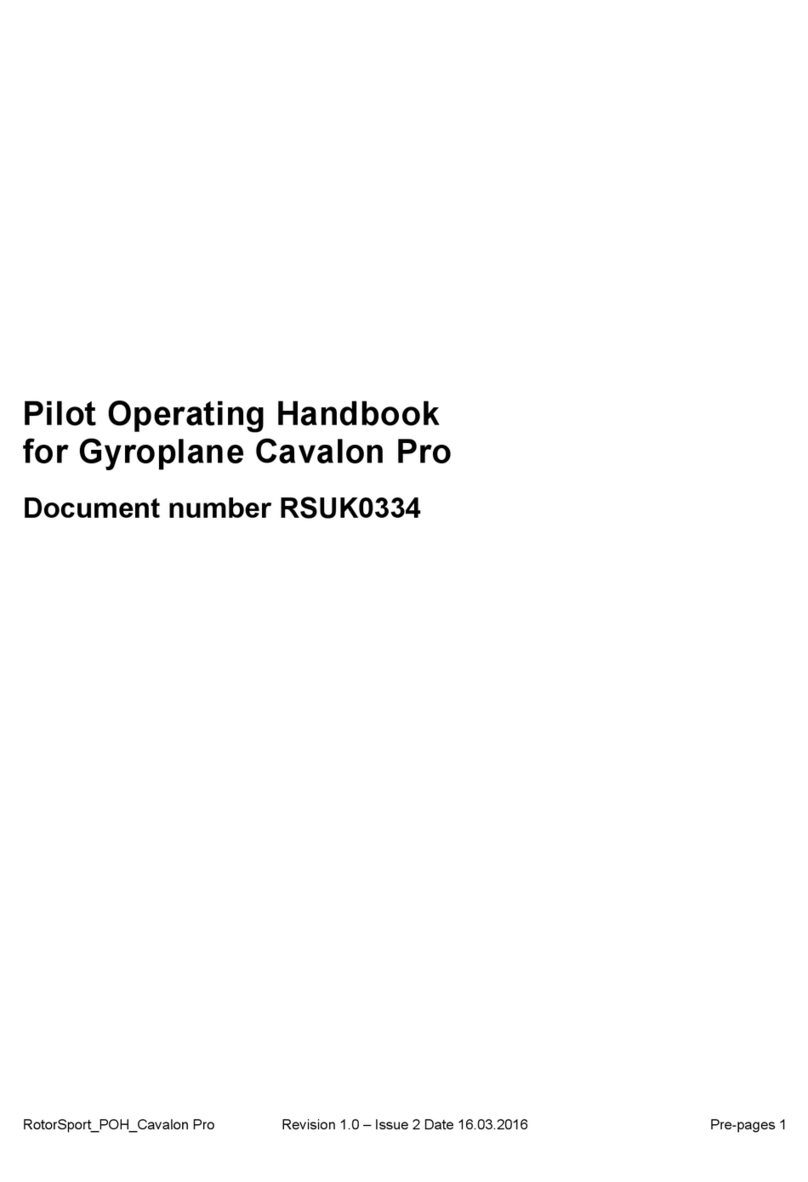
AUTO GYRO
AUTO GYRO Cavalon Pro Owner's manual
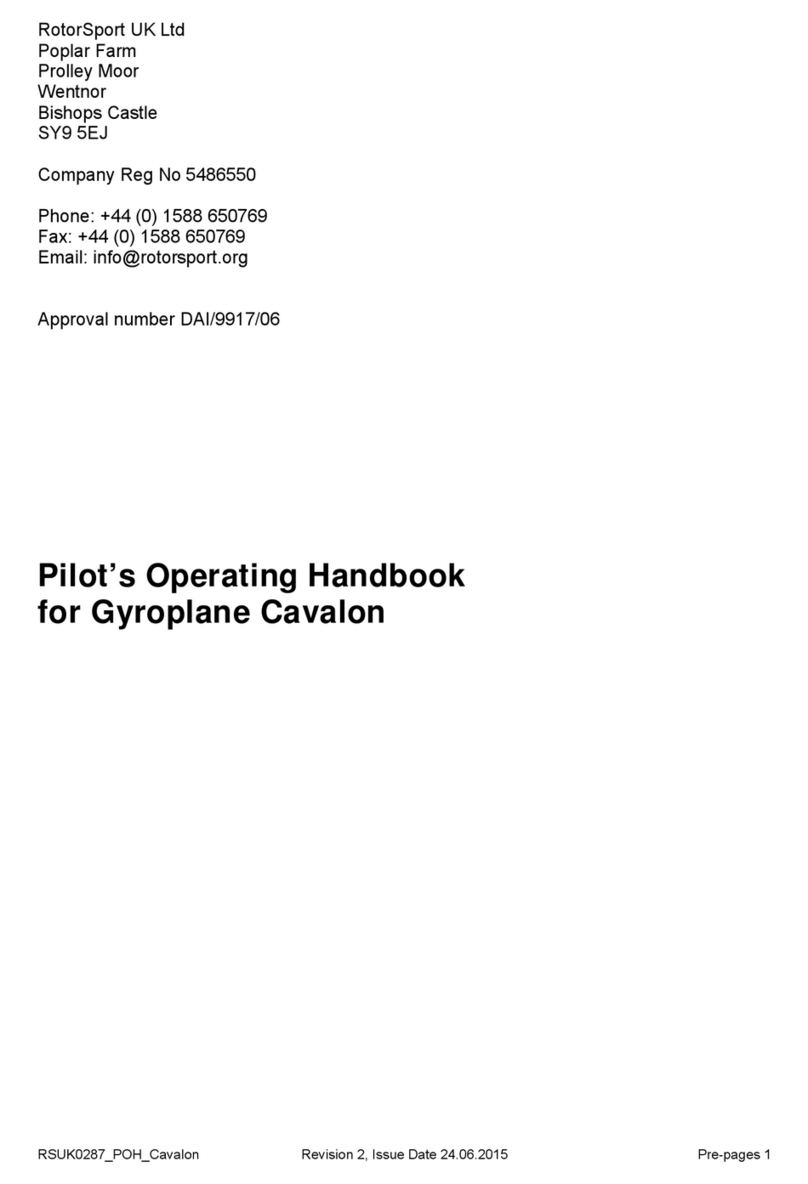
AUTO GYRO
AUTO GYRO CAVALON Owner's manual
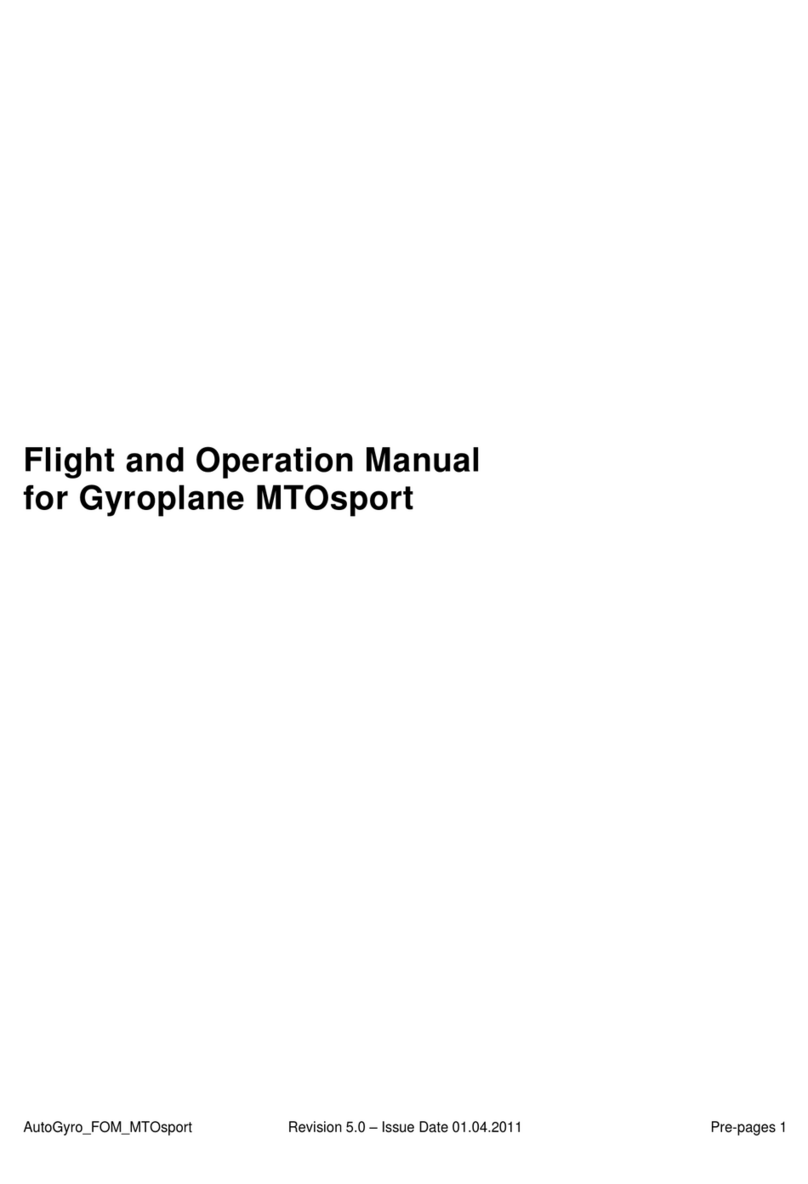
AUTO GYRO
AUTO GYRO MTOsport User manual
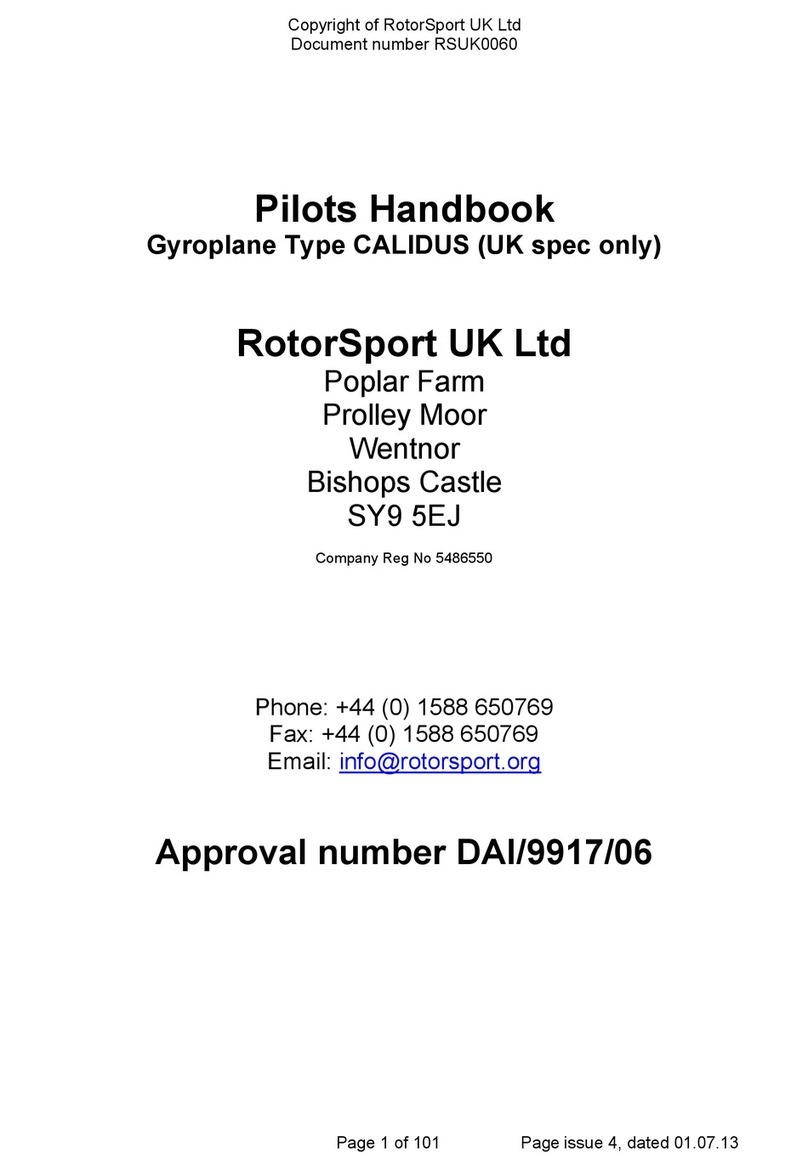
AUTO GYRO
AUTO GYRO RotorSport CALIDUS User manual
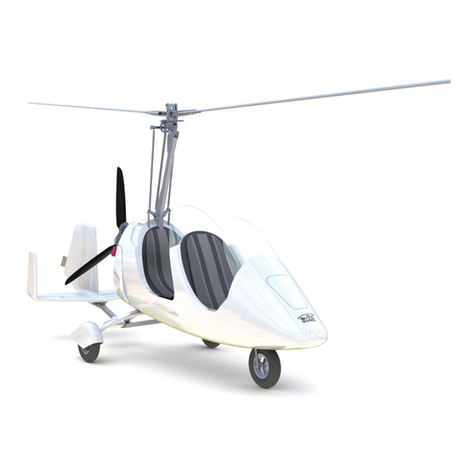
AUTO GYRO
AUTO GYRO MTOsport User manual
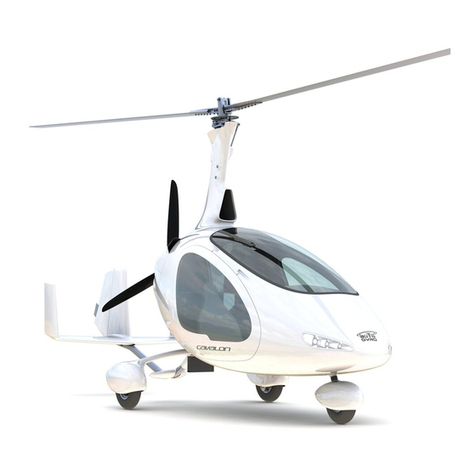
AUTO GYRO
AUTO GYRO CAVALON User manual
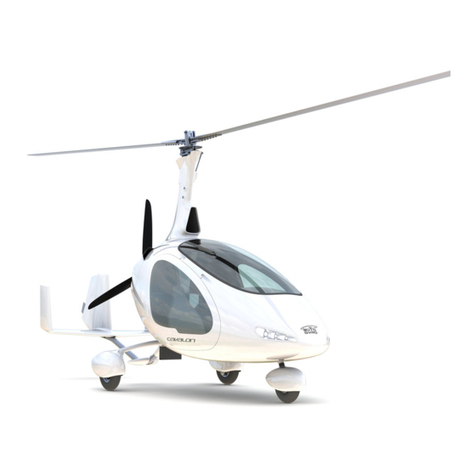
AUTO GYRO
AUTO GYRO Cavalon Owner's manual
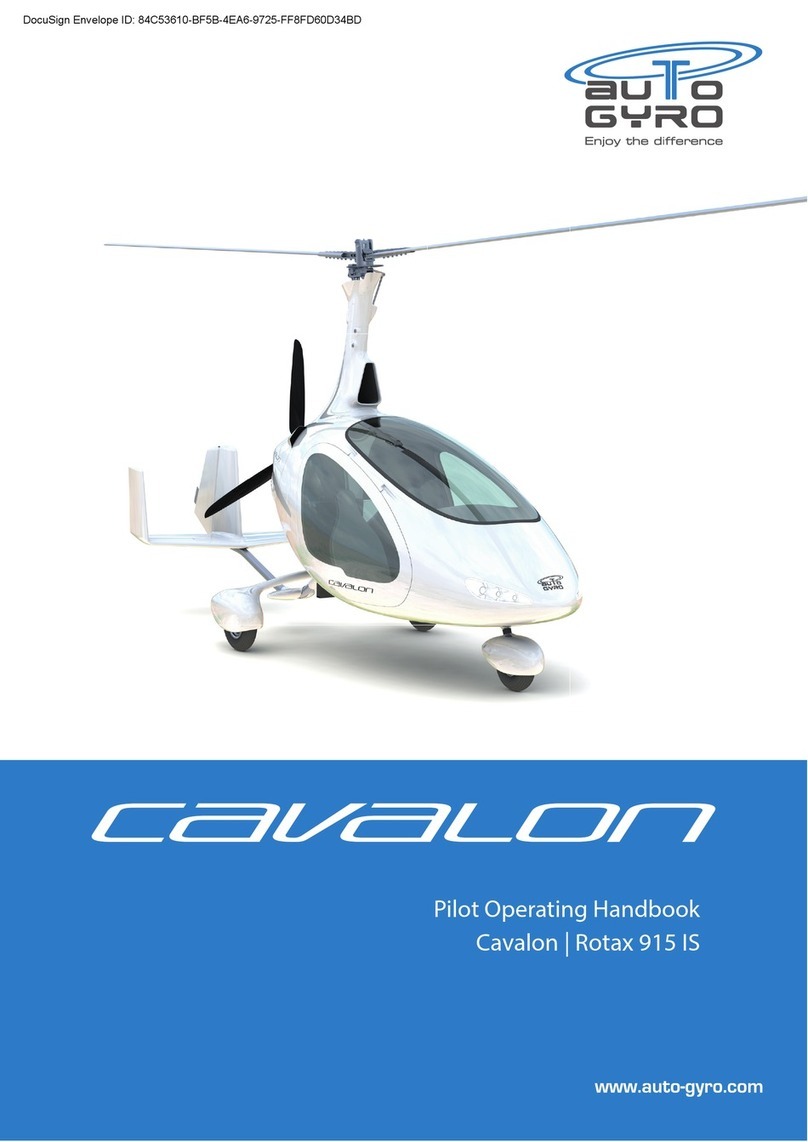
AUTO GYRO
AUTO GYRO Cavalon Rotax 915 IS Owner's manual



